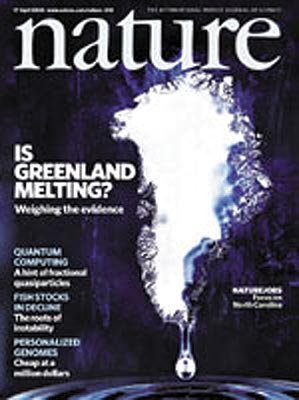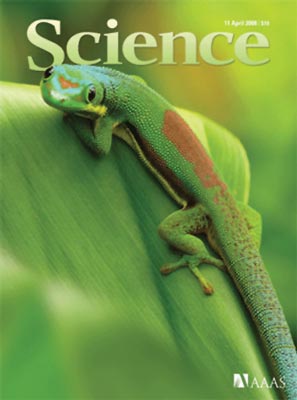Two of the world’s biggest science journals control their news coverage by giving sneak previews of research under embargo while limiting how scientists can interact with journalists. Jon Cartwright looks at whether the system benefits, or hinders, science communication

Late in the afternoon of Monday 19 June 2000, the US news website NASA Watch reported details of a classified briefing from NASA to the White House that concerned a potential landmark discovery in planetary science. Within 24 hours the news had spread onto other small websites, and after two days several of the world’s biggest media outlets, including the BBC and USA Today, were running the story on their homepages. Although the details were sketchy, the bottom line was clear: pictures from the Mars Global Surveyor spacecraft implied that the red planet had water on its surface.
The problem was that the stories appeared a little over a week early. In the eyes of the journal Science, in which the research was to be published, and NASA, which was to hold a press conference to announce the findings, NASA Watch had broken what is known as a science embargo — a system that aims to coordinate when the media report on new research.
As a result of the broken embargo, NASA decided to bring forward the press conference, while Science swiftly published the paper online to clarify the “varying degrees of accuracy” of the premature stories. But are the public and other scientists entitled to know about discoveries like this as soon as possible? Or is it right that research is embargoed, so that all journalists have an equal chance to report on it accurately?
Age-old system
Science embargoes date back to the emergence of dedicated science journalism in the 1920s. Around this time, the science editors of newspapers and news agencies began to demand advance copies of research papers in order to get to grips with difficult concepts and so prepare accurate stories. Publishers relented, and by the 1950s most elite journals were distributing preprints under embargo; in other words, stipulating that the editors should not run stories before the research papers were actually published.
Today, the two biggest journals employing embargo systems are Nature, published by Macmillan Publishers in the UK, and Science, published by the American Association for the Advancement of Science (AAAS). Both journals send preprints and summary press releases of upcoming research papers to journalists a little under a week in advance of publication; Science, for example, e-mails about 5400 journalists worldwide every week. In addition, media agencies such as EurekAlert!, also run by the AAAS, and AlphaGalileo, its European competitor, flood journalists’ inboxes daily with embargoed press releases from other journals and research institutions.
I don’t see why research that is being funded by the taxpayer should be manipulated by a private company for its commercial benefit David Whitehouse, freelance science writer
There is no legal obligation for journalists to adhere to embargoes. For this reason, the system is often referred to as a “gentleman’s agreement” in that it frees journalists from the pressure of tight deadlines while effectively guaranteeing journal publishers a spread of well-crafted news articles bearing the journal’s name. “I think [the embargo system] helps the media with complicated research,” says Ruth Francis, head of press relations at Nature. “It allows them time to gather information, speak to the researchers and know that they’ve got the story right.”
Not everyone agrees with this view. Some insist that the arbitrary timing of news coverage as dictated by embargoes gives the public the false impression that science is a progression of breakthroughs. Others object to the fact that embargoes ensure maximum coverage for a journal, because they allow slower reporters the time to catch up with those who are more able. “I mostly hate them,” says Dennis Overbye, science editor at the New York Times. “I think they serve the purpose of the journals very well. I’d just be happy to see them abolished.”
Media dissent
Given that embargoes are merely a gentleman’s agreement, where are the journalists who want to evade them? One journalist who prefers not to be the thrall of press officers is David Whitehouse, a freelance science writer who used to be science editor of BBC News Online. In fact, while Whitehouse was at the BBC he wrote one of the embargo-breaking news stories about water on Mars. “Yeah, we got in a bit of trouble about that,” he recalls.
Like other journalists who got wind of the Mars discovery early, Whitehouse was not able to put together an entirely accurate article. For example, he wrote that the images revealed “what appears to be brackish water seeping from beneath the Martian surface”, when in fact the images only showed the remnants of spring activity that could have been two million years old. (To this day there is still no consensus on the existence of surface water on Mars.) This error could be seen as a reason to favour embargoes, but it more likely highlights an awkward caveat of many embargo systems known as the Ingelfinger rule.
The rule, devised in 1969 by Franz Ingelfinger, then editor of the New England Journal of Medicine, states that scientists with papers pending publication must not discuss their work with journalists — essentially to prevent other scientists learning about the research from prior news stories rather than the journal. Nature and Science both employ variants of the Ingelfinger rule and only permit scientists to talk openly with journalists once an advance press release has been issued. This means that, even though Whitehouse and others sourced the information about the Mars discovery without the help of press officers — and so technically were free from the authority of Science’s embargo — they were unable to check facts with the scientists involved.
But Whitehouse says that sometimes he considered breaking embargoes even after he had received the Nature or Science preprint and press release. “You wouldn’t normally break an embargo that you’d agreed to,” he explains. “But if it was a humdinger of a story, you would, and you’d argue about it later. You’d say that the BBC was more important than Nature, [and] if you want to stop sending us your embargoed releases, then it’ll hurt you more than it’ll hurt us.”
Breaking embargoes is nothing new, although major cases are rare. In 1989 the University of Utah in the US invited journalists to a press conference to unveil a new type of room-temperature or “cold” fusion energy generation. But one of the scientists, Martin Fleischmann, unwittingly revealed details beforehand to a reporter from the Financial Times, which led to the UK newspaper running the story a day early. And way back in 1961, newspapers jumped the gun on new results from astrophysicist Martin Ryle that went against Fred Hoyle’s steady-state theory of the universe, in which new matter is supposed to be created endlessly to compensate for its expansion. As Hoyle’s theory was already unpopular with Christians, this led to the decisive headline from the Evening News: “The Bible was right”.
For Whitehouse, the main irritation of embargoes is that they “dragoon” everybody to report science news at the same time, which can only suit the “vested interests” of the journals. “They know that on a certain day, in certain newspapers, in certain outlets, their name is going to be mentioned,” he says. “And that is good for their advertising…I don’t see why research that is being funded by the taxpayer should be manipulated by a private company for its commercial benefit.”
Flawed articles
Naturally, press officers disagree. Ginger Pinholster, director of public programmes at Science, points out that the AAAS is a non-profit organization. She also believes that when one media outlet breaks an embargo, others must “scramble to catch up with the crowd”, sometimes producing flawed articles. “Distortion of research findings can jeopardize [both] public confidence in scientific discovery, and in funding for research, thus hindering advances that benefit society,” she says.
Most scientists contacted by Physics World were also at odds with Whitehouse’s argument. “[Embargoes] do not stop communication between scientists,” insists Andre Geim, a condensed-matter physicist from the University of Manchester in the UK. “They stop scientists making hype before [their work is published].”
If you’re frantic to be the first to publish, then frankly what you will come up with is not a very well researched story David Dickson, editor, SciDev.Net
Geim is correct to stress that, in general, scientists are not held back by embargo systems: the Ingelfinger rule adopted by Nature and Science still permits scientists to talk to each other, to speak at conferences and to upload preprints of their work to servers such as arXiv (though many are unaware that they can do the last). But the question is whether the public — and indeed scientists in unrelated fields — should also be privy to this circle of communication. In his 2006 book Embargoed Science, US journalist Vincent Kiernan suggests that shielding the public from scientists’ dialogue has the knock-on effect that they misunderstand the “essence” of scientific research, thereby leaving them open to pseudoscience. “The embargo,” he writes, “by promoting an unending stream of coverage of the ‘latest’ research findings, diverts journalists from covering the process of science, with all of its controversies and murkiness.”
Whitehouse also takes this view. “It’s a journalist’s job to reflect what’s going on, not to act as a cheerleader for science.” He adds that none of the reasons given by journal publishers for using embargoes has benefited him at all. “One of the reasons that the embargo was first put in place was to give everyone a level playing field. What journalist wants everybody to have the same chance? It’s ridiculous. Journalists by their nature are competitive and want to get their story out there first.”
No advantages
There is no doubt that the “level playing field” stymies the work of quick journalists by forcing them to wait for the embargo period to tick over. But some journalists contend that it is a small price to pay in order to communicate science accurately worldwide.
“In a lot of developing countries, journalists — even staff journalists — will be paid according to the number of words they get into a newspaper,” explains David Dickson, editor of the website SciDev.Net, which promotes effective science communication in the developing world. “And if the main stories that the news editor is interested in are the political or the sports or the crime stories, then those are the jobs that will get well paid…The cards are stacked against science reporters. If you think of all the hurdles that science journalists in developed countries face, just double them all.”
Dickson goes so far as to encourage trainee press officers to implement embargo systems. “If you’re frantic to be the first to publish, then frankly what you will come up with is not a very well researched story,” he says. As for the argument that the Ingelfinger rule inhibits reporting before publication, Dickson is not swayed. “When do you report on scientific research?” he asks. “When it’s in progress it’s actually rather boring. Why not wait until there’s something to report? That’s far more interesting.”
The truth is that even if the mainstream media were freer to cover more diverse research and incremental advances, they probably would not have the personnel to do so. For example, the Guardian, a UK daily newspaper, has nine science journalists to cover all disciplines. The New York Times has 17. BBC News has six, spread over various TV and radio programmes. In fact, such modest resources might be a symptom of present-day journalism in general. According to the recent book Flat Earth News by Nick Davies, a UK investigative journalist, on average just 20% of stories in quality UK newspapers are generated without the help of press releases or wire services. Davies has even coined a name for the modern practice: “churnalism”.
It is possible that if embargoes were removed, slower sections of the media would have to bow out of the race and switch their attention to the more overlooked journals such as Physical Review Letters (published by the American Physical Society), which has been devoid of anything resembling an embargo system for more than 30 years. Then again, they might simply give up on science reporting altogether. But whether or not embargoes are good for science communication, neither Science nor Nature has any plans to abandon them, so it looks as though they are here to stay. “They serve a lot of purposes,” Dickson continues. “They’re not written in stone. Everybody knows the rules. That’s the way journalism works.”
• Comment on this article below, or e-mail pwld@iop.org





